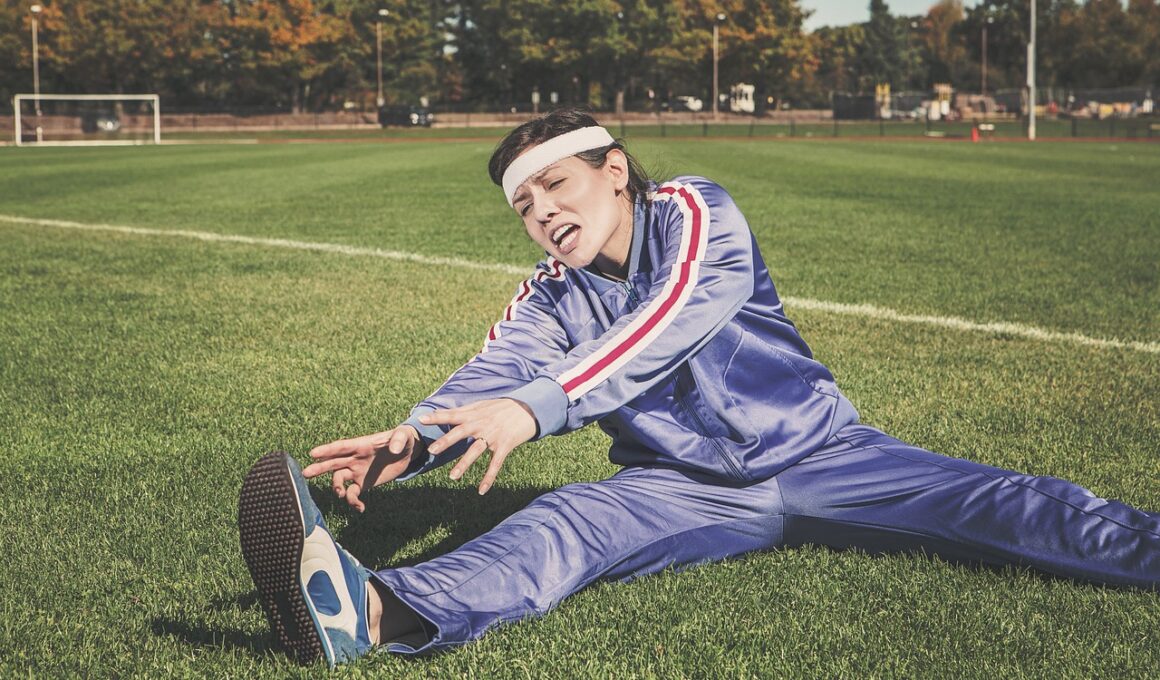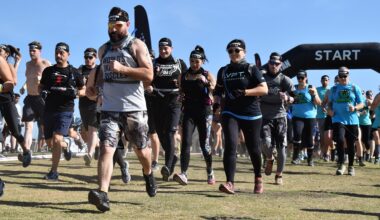How Stretching Can Enhance Your Athletic Performance
Stretching is a vital component of any fitness routine, particularly for athletes aiming to improve performance. When executed properly, stretching enhances flexibility, which is crucial for executing movements efficiently and safely. Not only does flexibility promote better athletic performance, but it also reduces the risk of injuries. Incorporating regular stretching into your workout regimen allows muscles to extend and compress without strain. Improved range of motion lets athletes perform activities more fluidly. Moreover, dynamic stretches should precede any physical activity, preparing the muscles for workout intensity. All athletes, regardless of their specific sport, should consider adding various stretching exercises to their fitness routines. Static stretches, performed post-workout, effectively elongate muscles and aid recovery. Engaging in appropriate stretches helps maintain optimal muscle function and health, enabling consistent workouts. A simple stretching routine can easily fit into even the busiest schedules, offering both immediate benefits and long-term advantages. Utilize stretches specific for muscle groups utilized in your sport for best results. Always remember that consistency matters when aiming for improved athletic performance through stretching.
Dynamic stretches have unique benefits for athletes and contribute to improved performance during games or competitions. These stretches involve movement, actively engaging muscles while increasing heart rate. Performing dynamic stretches increases blood flow and temperature, which are crucial for peak athletic function. Popular examples include leg swings, arm circles, and walking lunges. Dynamic stretching kicks off a workout, preparing not only the muscles but also the nervous system for action. In addition to enhancing physical readiness, dynamic stretching promotes mental readiness, boosting focus and concentration. On-field performance often hinges on the athlete’s mental state as much as the physical state. Preparatory movements can be tailored to mimic game scenarios, allowing athletes to simulate motions they will encounter during competitions. Regular practice of dynamic stretches cultivates muscle memory, enabling athletes to perform at their best under pressure. This adaptation means that during competitions, athletes will find themselves more adaptable and ready for unpredictable moments. The correct implementation of dynamic stretches requires attention and technique to prevent potential strain or injury. Always listen to your body and adjust your routine accordingly.
The Role of Static Stretching in Recovery
After intense workout sessions, static stretching plays an essential role in recovery. Static stretching involves holding a stretch for a given period, allowing the muscle fibers to relax and lengthen. Incorporating a series of static stretches post-workout helps reduce muscle soreness, promoting faster recovery times. These stretches typically focus on major muscle groups, such as hamstrings, quadriceps, and shoulders. Recovery means more than just resting; it involves actively aiding the body’s restoration processes. Static stretching accelerates blood flow, contributing nutrients required for muscle repair. By enhancing systemic circulation, athletes can minimize stiffness and improve their overall flexibility. Targeting specific tight areas can further enhance recovery, helping maintain a high level of athletic performance. However, it is essential to perform these stretches correctly. Holding a stretch too aggressively or not concentrating on breathing while stretching can lead to injury or reduced effectiveness. Athletes should aim for a gentle, controlled stretch, breathing deeply and evenly. Allowing proper time for engagement in post-workout stretching will ensure that muscle recovery remains optimal and prepares athletes for future challenges.
Stretching’s effects are not limited to just physical performance; they also play a significant role in mental well-being. Incorporating stretching routines regularly promotes a sense of calm and reduces anxiety levels. Engaging in stretching gives athletes a moment to disconnect and focus solely on their bodies and breathing, which is beneficial for stress management. Practices such as yoga utilize stretching combined with deep breathing and mindfulness, resulting in improved mental health. Mental clarity helps athletes improve their focus during workouts or competitions, contributing positively to overall performance. Furthermore, stretching can reduce the risk of athletic burnout by providing a balanced approach to training. Athletes need both physical and mental recuperation to perform optimally. Scheduling regular stretching sessions can function as a mental break, allowing athletes to reflect and reset. In high-stress environments, finding time for self-care practices can help cultivate a more sustainable approach to competing. Stretching sessions can be quick, yielding immediate mental benefits while fitting into busy routines. Consequently, athletes should include stretching as part of a comprehensive training program, promoting both physical abilities and mental resilience.
Best Practices for Stretching
To maximize the benefits of stretching, athletes should follow specific best practices. First, it’s essential to create a warm-up routine before stretching to prevent injuries. This may include light cardio activities for at least five to ten minutes. Next, during static stretches, it is crucial to breathe deeply and hold stretches for 15 to 30 seconds. Focusing on breath helps maintain a relaxed state and improves outcomes. Additionally, athletes must listen to their bodies and avoid pushing beyond their limits; discomfort can lead to injury or setbacks. Consistency is vital; integrating stretching into daily routines, even on non-training days ensures the regular enhancement of flexibility. Athletes should also target muscle groups that feel tight or sore and focus on areas relevant to their sport. Incorporating partner stretching occasionally can provide deeper stretches, as an additional person assists in causing tension and a greater stretch. Lastly, when unsure about specific techniques or stretches, seeking professional guidance from coaches or trainers is beneficial. Adopting these best practices will lead athletes toward better results and improved flexibility.
Monitoring progress in your stretching routine is crucial for achieving athletic gains. Keeping a fitness journal helps track stretching routines, noting any improvements in flexibility and recovery. Documenting specific stretches, durations, and sensations experienced during these exercises provides valuable feedback. Regular assessments of improvements help establish realistic goals, fostering motivation and commitment to routine. Celebrating successes, however small, encourages consistent effort, contributing positively to long-term growth. Additionally, engaging with fitness technology, such as apps or wearables, can further monitor progress effectively. Some apps provide tailored stretching routines while tracking stretch durations and flexibility gains over time. By establishing these metrics, athletes can recognize patterns and make adjustments to their routines. Consistent evaluation reveals whether stretching strategies are working or need modifications to facilitate improvement. Building a good stretching routine takes time, consistency, and commitment. Athletes should remember that progress will be gradual and unique to each individual. Embracing patience during the process ensures they remain focused on goals. Ultimately, monitoring stretching efficacy leads to better results and unforeseen breakthroughs in overall performance.
Conclusion
Incorporating stretching as a regular part of athletic training is essential for maximizing performance potential. Athletes benefit from both dynamic and static stretching, targeting their specific muscle groups to prevent injuries and promote recovery. Beyond physical advantages, stretching nurtures mental clarity, focus, and resilience. By practicing proper techniques, creating structured routines, and monitoring progress, athletes can optimize their stretching practices. As flexibility directly influences performance outcomes, yoga and other stretching programs can be beneficial supplements to traditional training. The link between effective stretching routines and athletic performance is evident and, when emphasized, leads to a well-rounded fitness journey. Consistent incorporation of stretching routines can save athletes from unnecessary injuries, ensuring they perform at their highest capacities. It is vital to approach stretching with intention and mindfulness to yield optimal benefits during workouts. Additionally, athletes should celebrate progress and maintain motivation throughout the journey. True growth takes place over time, but effective stretching practices will lead to long-lasting improvements in performance. Make stretching an essential and enjoyable part of your fitness routine, and watch your athletic potential soar.
Regardless of sport, understanding how stretching contributes to athletic excellence can help enhance anyone’s training regimen. The commitment to incorporating stretching in a routine is a lifelong investment in performance and health. Effective stretching practices lead to greater enjoyment in sports, reduced injury occurrences, and elevated capabilities. Therefore, aim to find joy in the journey of mastering stretching techniques while also improving performance and fitness. Evaluate your progress and adapt practices regularly to ensure optimal results. Athletes present a range of capabilities, but stretching is universal and necessary for all. Always remember to pay attention to your body and avoid overextending beyond limits. Keep yourself educated on effective stretching practices, as this knowledge will provide countless benefits. The world of fitness is constantly evolving, and so are stretching techniques. Engage with the latest practices and research to enhance your understanding. Lastly, foster a supportive network of fellow athletes who care about stretching and recovery. Sharing experiences helps bolster motivation, contributes to monitoring progress, and can create connections to enrich personal performance journeys.


